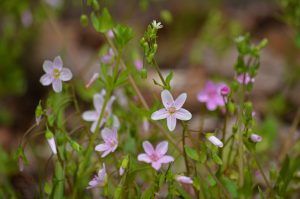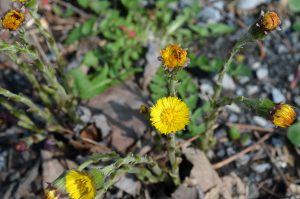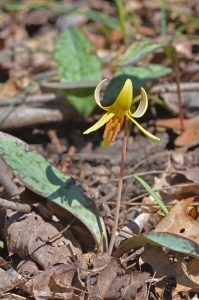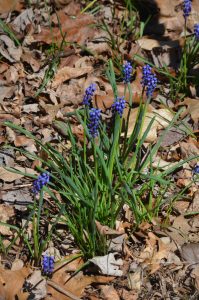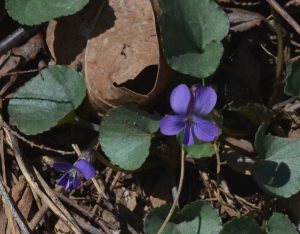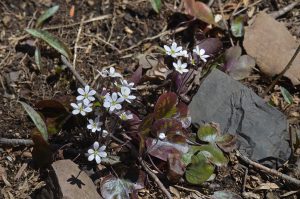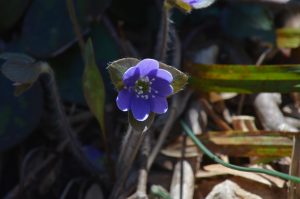There they were. Just popping up out of the leaf litter of the forest floor. If I hadn’t stopped to listen to a distant Red-bellied Woodpecker sounding out his territorial call, I would have walked right by the small, group of delicate, white wildflowers, with faint pink striping. I recognized them instantly, since they’re one of the first woodland wildflowers to bloom in the spring, hence their name-Spring Beauty!
Spring Beauties (left) and Coltsfoot (right) are two, early-blooming spring wildflowers
This past weekend I dashed out for my annual spring wildflower walk, to a location that I knew had a good variety. Although I was two weeks earlier than my normal search time, I still managed to find a good variety of species just beginning to emerge from their winter rest. They begin blooming as early as March, although this year, a few friends had told me they found very early blooms during the bright, warm days of late February. By June, all but a few of the woodland wildflowers are past their peak bloom times, and if your timing is off, you’ll miss seeing them altogether and have to wait another year to witness this, quiet forest extravaganza!
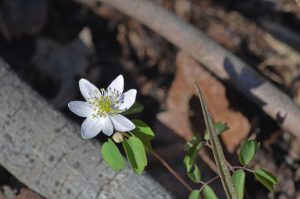
A friend once asked me, “What exactly is the definition of a wildflower?” I’m no botanist, but I answered his question by breaking the word down-wild and flower. Simply put, a wildflower is a plant that grows in nature without being managed by humans, and is usually colorful and produces seeds. There are native species, and non-native species. A native wildflower is one that has been growing here since before Europeans settled here (1600’s). Non-natives are not originally from this country, but were brought by settlers and planted here. Some species escaped (spread) by accident, and others were planted in nature on purpose. OK, that’s your wildflower science lesson, now let’s cover some of the more interesting and fun facts about these plants!
Wild Grape Hyacinth (above left), Wood Violet (above right) and Hepatica below (both white and blue)
There’s nearly 2,000 species of wildflowers that grown in Pennsylvania. They can be found growing just about anywhere, from roadsides to fields to steep mountains. When it comes to the spring wildflowers, the one thing these plants share is that their bloom time is pretty short. I’ve found a few species that were just getting ready to burst, returned as little as a week later, and the main flower had already wilted. They come in all shapes and colors, like the yellow Trout Lily, which gets its name from the markings on its leaves that looks like the skin of a Brook Trout. Or, the white-colored Bloodroot, an early spring flower that oozes bright, red-orange (blood-looking) sap if any part of the plant is broken. This is how the plant got its name. Native Americans used this sap as a dye.
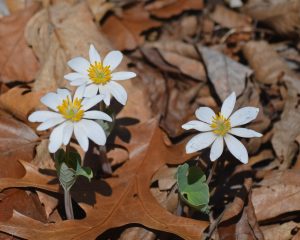
One of my favorite spring wildflowers is the Mayapple. This umbrella-looking flower grows on the forest floor and has one large single or double canopy-like leaf that covers the flower growing below it. Its name comes from the fruit that develops after the flower is done blooming, usually in the month of May. Mayapples grow in large colonies. When I was a kid growing up in NE PA, I would find stands of Mayapples and try to lie down beneath them looking up through their “umbrellas” and imagining I was only a few inches tall standing in a giant rainforest. Last year I found a huge cluster of these in a local state park. With no one watching, I tried to turn back time, and once again, I carefully laid down among them, trying to gaze up at their large leaves. The only problem I found was that the plants weren’t as tall as I remembered them when I was 10 years old. I wasn’t seeing anything above me, except me! Then it hit me, maybe the plants haven’t changed, maybe the curious naturalist grew larger! Maybe that green canopy above me was my gut, hiding under my green sweatshirt and looking more like a large piece of moss, rather than the Mayapples that surrounded me. With knees creaking, I slowly arose, groaning like an old bear coming out of hibernation, flicked off the slug that took up residence on my shoulder and cautiously left the Mayapples to themselves. Oh well, it’s the thought that counts, right?
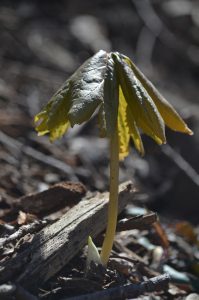
I love springtime in an Eastern deciduous forest. The birds are starting to sing, the trees are just beginning to leaf out, and those elegant, colorful wildflowers. Their beauty and the important role they play in early pollination in our natural ecosystem is more than enough reason to enjoy these valuable plants. As Thomas Wentworth Higginson wrote, “The first wild-flower of the year is like land after sea.” I couldn’t agree more!
